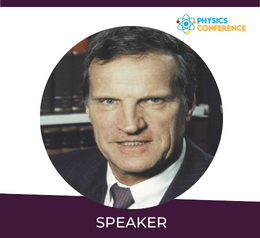Scholars International Conference on
PHYSICS AND QUANTUM PHYSICS
THEME: "Frontiers in Physics and Quantum Physics"
 22-23 Jun 2022
22-23 Jun 2022  NH Potsdam, Berlin, Germany & Online
NH Potsdam, Berlin, Germany & Online THEME: "Frontiers in Physics and Quantum Physics"
 22-23 Jun 2022
22-23 Jun 2022  NH Potsdam, Berlin, Germany & Online
NH Potsdam, Berlin, Germany & Online 
Max-Planck Institute for Chemical Physics of Solids, Germany
Title: Interplay of heavy-fermion quantum criticality and unconventional superconductivity
Frank Steglich is director emeritus at the Max Planck Institute for Chemical Physics of Solids (MPI CPfS) Dresden. He obtained his PhD in 1969 in Göttingen and his habilitation in 1976 at Cologne University. 1978-1998 he was professor of physics at Darmstadt Technical University; in 1996, he became founding director of the MPI CPfS. In 2012, he retired and became founding director of the Center for Correlated Matter at Zhejiang University, Hangzhou, China. His research interests include quantum criticality and superconductivity. In 1979, he discovered superconductivity (Tc=0.6 K) in the heavy-fermion metal CeCu2Si2, the first unconventional (non-phonon-driven) superconductor. He is a Fellow of the APS (2015), a member of several academies and received the Leibniz Prize (1986), EPS Hewlett-Packard as well as Gay-Lussac-Humboldt Prize (1989), APS International Prize for New Materials (1990), IUPAP Magnetism Award (2000), Stern-Gerlach Medal (2004), B.T. Matthias Prize (2006) and Fritz London Memorial Prize (2020).
According to the ‘Quantum Critical Paradigm’, antiferromagnetic (AF) quantum critical points (QCPs) in pristine heavy-fermion metals cause emergent unconventional superconductivity. This will be demonstrated for both tetragonal CeCu2Si2, the first discovered unconventional superconductor [F. Steglich et al., Phys. Rev. Lett. 43, 1892 (1979)], and isostructural YbRh2Si2. CeCu2Si2 exhibits a 3D itinerant (SDW-type) QCP [O. Stockert et al., Nature Phys. 7, 119 (2011)] and was considered a dwave superconductor for many years, until its low-temperature specific heat was found to follow an exponential temperature dependence [S. Kittaka et al., Phys. Rev. Lett. 112, 067002 (2014)]. Due to atomic-substitution, neutron-scattering, penetration-depth [G. M. Pang et al., Proc. Natl. Acad. Sci. USA 115, 5343 (2018)] and ARPES [Z.Z. Wu et al., Phys. Rev. Lett. 127, 067002 (2021)] results, CeCu2Si2 is neither an isotropic nor anisotropic s-wave superconductor. It rather shows fully gapped two-band dwave superconductivity [E. M. Nica and Q. Si, npj Quantum Materials 2, 24 (2017); 6, 3 (2021)]. YbRh2Si2 exhibits a magnetic-field-induced local (‘partial-Mott’) AF QCP at BN ? 60 mT (B:perpendicular to the tetragonal c-axis). No superconductivity could be detected above 10 mK. However, magnetic and specific-heat measurements performed down to 0.8 mK revealed heavy-fermion superconductivity below Tc = 2 mK [E. Schuberth et al., Science 351, 485 (2016)]. This is ascribed to the competition between a nuclear-dominated AF hybrid order (TA = 2.3 mK) and the primary AF 4felectronic order (TN= 70 mK), by which the system is pushed towards a (presumably local) QCP. Recent electrical-resistivity measurements at ultra-low temperatures strongly suggest the occurrence of superconductivity up to magnetic fields of order BN [D.H. Nguyen et al., Nature Commun. 12, 4341 (2021)]. The whole of these observations confirms the relevance of the ‘Quantum Critical Paradigm’, regardless of the microscopic (itinerant vs. local) nature of the AF instability.